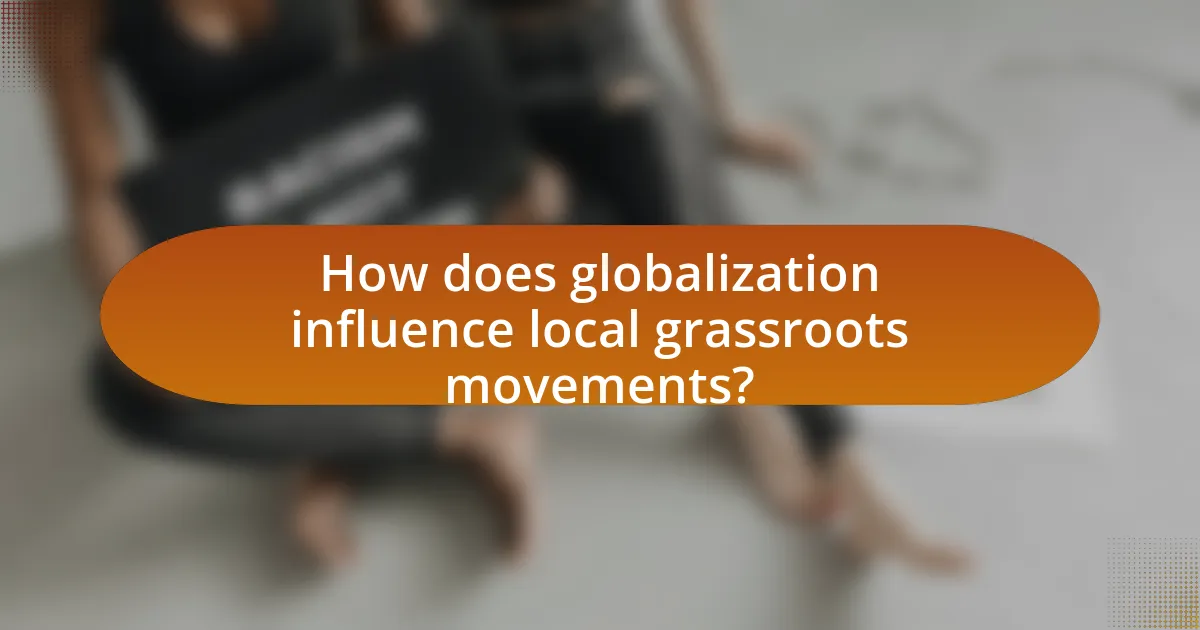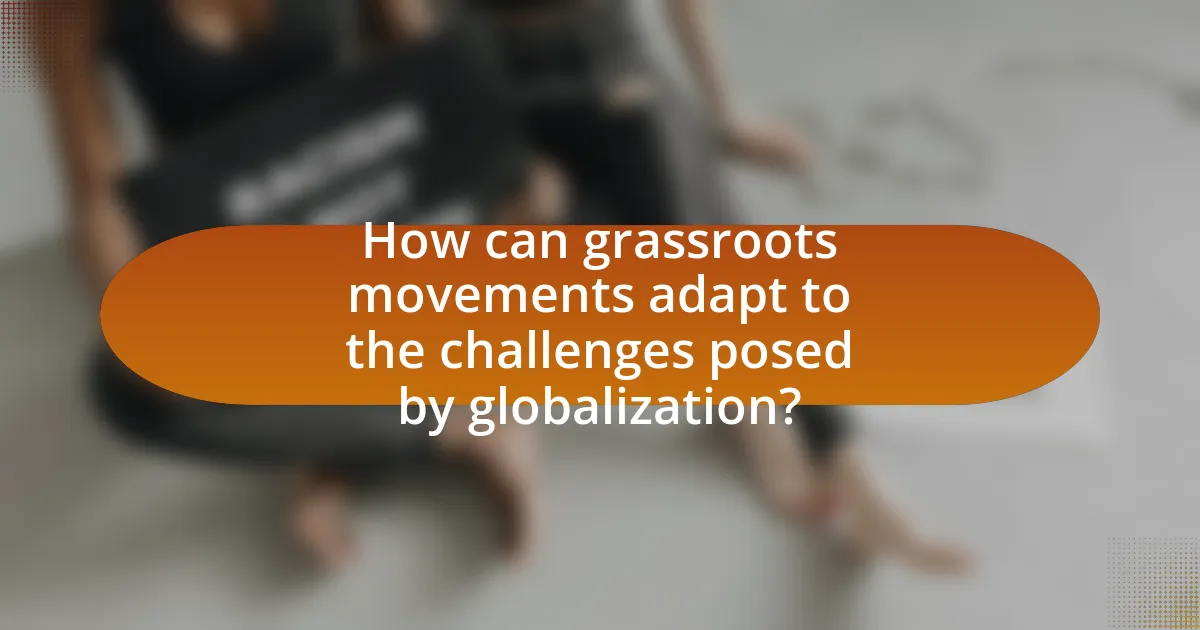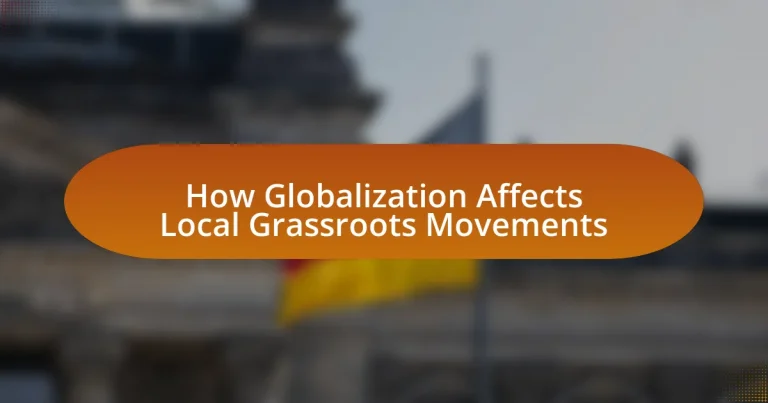The article examines how globalization influences local grassroots movements, highlighting the exchange of ideas, resources, and strategies that enhance their effectiveness. It outlines key characteristics of grassroots movements, such as community-driven participation and local leadership, and contrasts them with traditional organizations. The article also discusses the impact of globalization on local cultures, the role of social media in activism, and the challenges grassroots movements face, including competition for resources and political repression. Additionally, it explores strategies for adaptation and collaboration with global networks, emphasizing the importance of community engagement and the potential for grassroots movements to leverage globalization for greater impact.

How does globalization influence local grassroots movements?
Globalization influences local grassroots movements by facilitating the exchange of ideas, resources, and strategies across borders, which enhances their effectiveness and reach. For instance, grassroots organizations can leverage global communication platforms to mobilize support and share best practices, as seen in movements like the Arab Spring, where social media played a crucial role in organizing protests. Additionally, globalization can lead to increased awareness of local issues on a global scale, attracting international attention and support, exemplified by the global climate movement, which has united local activists under a shared cause. This interconnectedness allows grassroots movements to adapt and respond to global trends while maintaining their local focus.
What are the key characteristics of grassroots movements?
Grassroots movements are characterized by their community-driven nature, emphasizing local participation and leadership. These movements typically arise from the collective efforts of individuals at the local level, often in response to specific social, political, or environmental issues. They rely on grassroots organizing strategies, such as mobilizing community members, fostering collaboration, and utilizing social networks to amplify their message. Additionally, grassroots movements often prioritize inclusivity and democratic decision-making, ensuring that diverse voices within the community are heard and represented. Historical examples, such as the Civil Rights Movement in the United States, illustrate how grassroots efforts can lead to significant societal change, demonstrating the effectiveness of local activism in addressing broader systemic issues.
How do grassroots movements differ from traditional organizations?
Grassroots movements differ from traditional organizations primarily in their structure and approach to mobilization. Grassroots movements are typically decentralized, relying on community participation and local leadership, whereas traditional organizations often have a hierarchical structure with formal leadership and established protocols. For example, grassroots movements like the Civil Rights Movement in the United States emerged from local communities advocating for change, while traditional organizations such as corporations or government agencies operate within a defined framework and follow established procedures. This fundamental difference in organization leads to grassroots movements being more adaptable and responsive to local needs, as evidenced by their ability to quickly mobilize support for specific issues, such as environmental justice or social equity, often without the bureaucratic delays seen in traditional organizations.
What roles do community engagement and local leadership play in grassroots movements?
Community engagement and local leadership are crucial in grassroots movements as they foster participation, build trust, and mobilize resources. Community engagement ensures that the voices of local residents are heard, allowing movements to address specific needs and concerns effectively. Local leadership provides direction and organization, enabling groups to strategize and implement actions that resonate with the community’s values. For instance, studies show that grassroots movements with strong local leadership, such as the Civil Rights Movement in the United States, were more successful in achieving their goals due to effective community mobilization and engagement. This dynamic creates a sense of ownership among community members, enhancing the movement’s sustainability and impact.
In what ways does globalization impact local cultures?
Globalization impacts local cultures by facilitating the exchange of ideas, values, and practices, which can lead to cultural homogenization. This process often results in the dilution of unique cultural identities as global influences, such as Western media and consumer products, become dominant. For instance, the proliferation of fast-food chains worldwide has altered local eating habits and culinary traditions, as seen in countries like India, where traditional diets are increasingly replaced by Western-style fast food. Additionally, globalization can foster cultural exchange and innovation, allowing local cultures to adapt and incorporate new elements while still maintaining their core identities. However, the balance between adaptation and preservation is delicate, and excessive globalization can threaten the survival of indigenous languages and traditions, as evidenced by UNESCO reports indicating that many languages are at risk of extinction due to global cultural pressures.
How does the spread of information affect local activism?
The spread of information significantly enhances local activism by increasing awareness and mobilizing community members around specific issues. Access to diverse platforms, such as social media and online forums, allows activists to disseminate information rapidly, engage a broader audience, and coordinate actions effectively. For instance, the Black Lives Matter movement utilized social media to raise awareness about racial injustice, leading to widespread protests and policy discussions across various localities. This demonstrates that timely and accessible information can galvanize community support and drive collective action, ultimately influencing local policies and social change.
What are the implications of cultural exchange on grassroots initiatives?
Cultural exchange significantly enhances grassroots initiatives by fostering collaboration, innovation, and community engagement. When diverse cultural perspectives are integrated into local movements, they can lead to more inclusive and effective solutions that address specific community needs. For instance, research by the International Journal of Cultural Studies highlights that grassroots organizations that embrace cultural diversity often experience increased participation and support from various demographic groups, thereby strengthening their impact. This collaborative environment not only enriches the initiatives but also promotes social cohesion and mutual understanding among community members.

What challenges do grassroots movements face in a globalized world?
Grassroots movements face significant challenges in a globalized world, primarily due to competition for attention and resources. Globalization amplifies the presence of numerous social issues, making it difficult for local movements to stand out and gain support. For instance, the rise of transnational organizations often overshadows local initiatives, diverting funding and media coverage away from grassroots efforts. Additionally, grassroots movements frequently struggle with the complexities of navigating global networks, which can lead to misalignment in goals and strategies. Research indicates that local movements may also face repression from state actors who perceive them as threats to national interests, particularly when their agendas conflict with global economic policies. These challenges highlight the need for grassroots movements to adapt and innovate in order to effectively advocate for their causes in an interconnected world.
How does economic globalization affect local grassroots efforts?
Economic globalization often undermines local grassroots efforts by prioritizing multinational corporate interests over community needs. This phenomenon can lead to the erosion of local economies, as small businesses struggle to compete with larger, global entities that benefit from economies of scale and lower production costs. For instance, a study by the International Labour Organization found that globalization can result in job losses in local sectors, particularly in developing countries, where local artisans and small-scale farmers face competition from imported goods. Consequently, grassroots movements aimed at promoting local sustainability and community welfare may find their initiatives stifled, as funding and resources are diverted to support larger, global projects that do not align with local priorities.
What are the effects of multinational corporations on local activism?
Multinational corporations significantly influence local activism by often undermining grassroots movements through economic power and political lobbying. These corporations can exert pressure on local governments to prioritize their interests, which may lead to the suppression of local activist efforts aimed at environmental protection, labor rights, or social justice. For instance, a study by the International Labour Organization found that multinational companies frequently engage in practices that weaken labor unions and diminish workers’ rights, thereby stifling local activism that seeks to improve conditions for workers. Additionally, the presence of multinational corporations can lead to a phenomenon known as “corporate social responsibility washing,” where companies promote superficial community engagement initiatives that distract from genuine local activism.
How do funding sources influence the direction of grassroots movements?
Funding sources significantly influence the direction of grassroots movements by determining the resources available for advocacy, outreach, and operational capacity. When grassroots movements receive funding from specific organizations or donors, their agendas may align with the interests or priorities of those funding sources, which can shape the movement’s goals and strategies. For instance, research by the Institute for Policy Studies highlights that funding from large philanthropic organizations can lead grassroots movements to focus on issues that resonate with the funders’ missions, potentially sidelining local concerns that may not align with those priorities. This dynamic can create a dependency on external funding, which may limit the movement’s autonomy and ability to address grassroots issues authentically.
What political challenges arise for grassroots movements in a global context?
Grassroots movements face significant political challenges in a global context, primarily due to the influence of transnational corporations and international political structures. These entities often prioritize profit and stability over local needs, which can undermine grassroots initiatives aimed at social change. For instance, the 2016 protests against the Dakota Access Pipeline in the United States highlighted how local movements can be stifled by federal policies and corporate interests that disregard indigenous rights and environmental concerns. Additionally, grassroots movements frequently encounter difficulties in mobilizing resources and gaining visibility on a global scale, as larger organizations and media outlets may overshadow their efforts. This disparity can lead to a lack of representation and support for local issues, further complicating their political landscape.
How do international policies impact local grassroots initiatives?
International policies significantly influence local grassroots initiatives by shaping the regulatory environment, funding opportunities, and advocacy frameworks. For instance, international agreements on climate change, such as the Paris Agreement, encourage local movements to align their goals with global sustainability targets, often leading to increased support and resources from international NGOs. Additionally, trade policies can either empower or hinder local initiatives by affecting local economies; for example, fair trade policies can enhance grassroots efforts by providing better market access for local producers. These dynamics illustrate how international frameworks can either bolster or constrain the effectiveness of local grassroots movements, ultimately impacting their ability to achieve social and environmental objectives.
What role does social media play in shaping political landscapes for grassroots movements?
Social media significantly influences political landscapes for grassroots movements by facilitating communication, mobilization, and awareness. It allows grassroots organizations to reach a broader audience quickly, enabling them to share their messages and rally support effectively. For instance, during the Arab Spring, platforms like Twitter and Facebook were instrumental in organizing protests and disseminating information, leading to substantial political changes in several countries. Research by the Pew Research Center indicates that 69% of adults in the U.S. use social media, highlighting its potential as a tool for grassroots movements to engage and mobilize citizens around political issues.

How can grassroots movements adapt to the challenges posed by globalization?
Grassroots movements can adapt to the challenges posed by globalization by leveraging digital platforms for organization and outreach. These movements can utilize social media and online communication tools to connect with a broader audience, share their messages, and mobilize support across geographical boundaries. For instance, the Arab Spring demonstrated how social media facilitated grassroots activism, allowing local movements to gain international attention and support. Additionally, grassroots organizations can form coalitions with other groups globally to share resources, strategies, and best practices, enhancing their resilience against the pressures of globalization. This collaborative approach can amplify their impact and ensure that local voices are heard in global discussions.
What strategies can grassroots movements employ to remain effective?
Grassroots movements can remain effective by employing strategies such as building strong community networks, leveraging social media for outreach, and focusing on local issues that resonate with constituents. Strong community networks foster collaboration and trust, which are essential for mobilizing support and resources. For instance, the Black Lives Matter movement effectively utilized social media platforms to amplify its message and organize protests, demonstrating the power of digital engagement in grassroots activism. Additionally, addressing local issues allows movements to connect with the immediate concerns of their communities, ensuring sustained interest and participation. Research indicates that grassroots movements that align their goals with the specific needs of their communities are more likely to achieve lasting impact and influence policy changes.
How can collaboration with global networks enhance local efforts?
Collaboration with global networks enhances local efforts by providing access to resources, knowledge, and best practices that can be adapted to local contexts. For instance, local grassroots movements can leverage global funding opportunities, such as those offered by international NGOs, which can significantly increase their operational capacity. Additionally, partnerships with global organizations facilitate knowledge exchange, allowing local groups to learn from successful strategies implemented elsewhere, as evidenced by the World Wildlife Fund’s collaboration with local conservation groups to implement effective environmental practices. This synergy not only strengthens local initiatives but also amplifies their impact on broader social and environmental issues.
What best practices can grassroots movements adopt to leverage globalization?
Grassroots movements can leverage globalization by utilizing digital platforms for outreach and collaboration. These platforms enable movements to connect with a global audience, share resources, and mobilize support across borders. For instance, social media has been instrumental in campaigns like the Arab Spring, where grassroots organizations effectively used these tools to organize protests and disseminate information rapidly. Additionally, forming alliances with international NGOs can enhance visibility and provide access to funding and expertise, as seen in the collaboration between local environmental groups and global organizations like Greenpeace. By adopting these practices, grassroots movements can amplify their impact and foster a more interconnected approach to advocacy.
What resources are available for grassroots movements to navigate globalization?
Grassroots movements can access various resources to navigate globalization, including digital platforms, funding opportunities, and collaborative networks. Digital platforms like social media enable grassroots organizations to amplify their messages and connect with a global audience, facilitating awareness and support. Funding opportunities from international NGOs and philanthropic organizations provide financial backing for initiatives aimed at addressing local issues influenced by global trends. Collaborative networks, such as coalitions and alliances with other grassroots movements, allow for shared knowledge and strategies, enhancing their capacity to respond to globalization’s challenges. These resources collectively empower grassroots movements to effectively advocate for their communities in a globalized context.
How can local movements access global funding and support?
Local movements can access global funding and support by leveraging online platforms, building partnerships with international NGOs, and participating in global networks. Online crowdfunding platforms like GoFundMe and Kickstarter allow local initiatives to reach a wider audience, while partnerships with established NGOs can provide credibility and access to resources. Additionally, engaging in global networks, such as the Global Fund for Community Foundations, enables local movements to connect with potential funders who are interested in supporting grassroots efforts. These strategies have been effective; for instance, the Global Fund for Community Foundations has distributed over $100 million to local initiatives worldwide, demonstrating the viability of these approaches.
What tools and platforms can assist grassroots movements in their advocacy efforts?
Grassroots movements can utilize various tools and platforms to enhance their advocacy efforts, including social media, crowdfunding platforms, and advocacy software. Social media platforms like Facebook, Twitter, and Instagram enable grassroots organizations to reach a wider audience, mobilize supporters, and share their messages quickly. Crowdfunding platforms such as GoFundMe and Kickstarter allow these movements to raise funds for their initiatives directly from supporters. Additionally, advocacy software like NationBuilder and Action Network provides tools for organizing campaigns, managing contacts, and analyzing outreach efforts, which can significantly improve the effectiveness of grassroots advocacy. These tools collectively empower grassroots movements to amplify their voices and achieve their goals more efficiently.
What are the future prospects for grassroots movements in a globalized world?
The future prospects for grassroots movements in a globalized world are promising, as these movements increasingly leverage digital platforms to mobilize support and raise awareness. The rise of social media has enabled grassroots organizations to connect with a global audience, facilitating the sharing of ideas and strategies across borders. For instance, the Arab Spring demonstrated how local movements could gain international attention and support through online platforms, leading to significant political changes. Additionally, global issues such as climate change and social justice have prompted grassroots movements to collaborate internationally, enhancing their impact and reach. This interconnectedness allows for resource sharing and solidarity, which can strengthen local initiatives and amplify their voices on a global stage.
How might emerging trends in globalization shape grassroots activism?
Emerging trends in globalization significantly shape grassroots activism by facilitating cross-border collaboration and increasing access to information. As technology advances, activists can connect with like-minded individuals globally, sharing strategies and resources that enhance local movements. For instance, the rise of social media platforms has enabled grassroots organizations to mobilize support rapidly, as seen in movements like the Arab Spring, where digital communication played a crucial role in organizing protests. Additionally, globalization fosters awareness of global issues, prompting local activists to align their efforts with international campaigns, thereby amplifying their impact. This interconnectedness allows grassroots movements to leverage global networks for funding and advocacy, ultimately strengthening their local initiatives.
What lessons can be learned from successful grassroots movements worldwide?
Successful grassroots movements worldwide demonstrate the importance of community engagement, strategic communication, and adaptability. These movements often thrive when they mobilize local populations around shared goals, as seen in the Civil Rights Movement in the United States, which effectively united diverse groups to advocate for social justice. Additionally, successful movements utilize social media and other communication tools to amplify their message and reach broader audiences, exemplified by the Arab Spring, where digital platforms played a crucial role in organizing protests. Furthermore, adaptability is vital; movements that can pivot in response to changing political landscapes, like the environmental movement’s shift towards climate justice, tend to sustain momentum and achieve long-term impact. These lessons highlight the effectiveness of grassroots strategies in addressing local issues within a global context.


